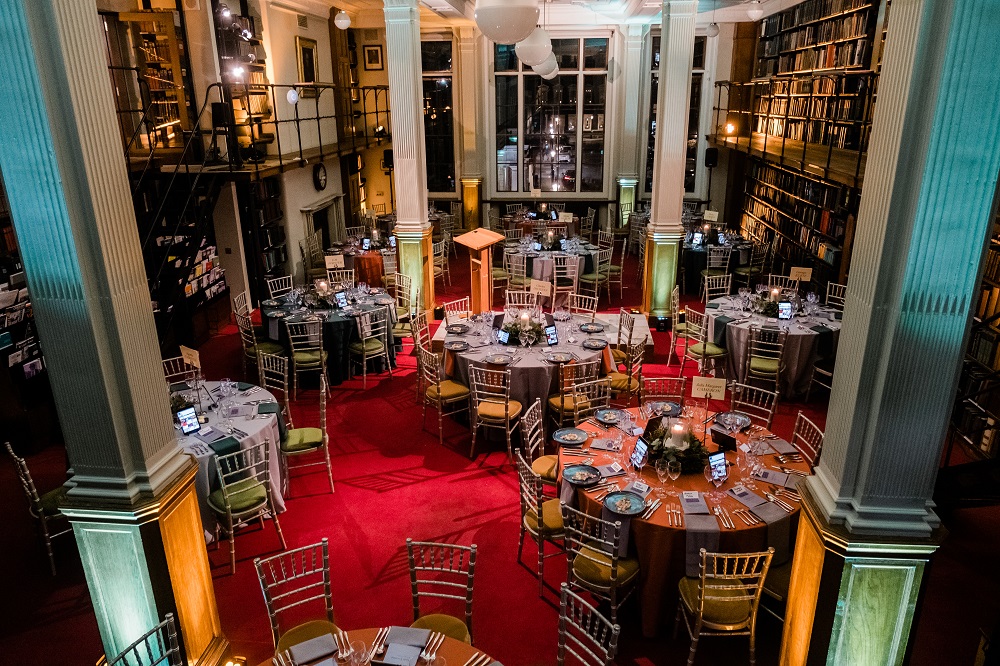Whether simple or sumptuous in design, book boxes give essential protection to many items in The London Library’s collections, including some of our rarest, quirkiest and most valuable volumes. Our Head of Collection Care Judith Finnamore explains how she and her Conservation team go about their work.
The benefits of boxes
Boxes can provide an effective barrier against some of the enemies of paper. Exposure to light causes chemical reactions in paper, leading it to discolour and turn brittle. If you’ve ever left a newspaper on a sunny windowsill over weeks or months, you’ll have some idea of what this looks like. Dust can also be detrimental, endangering books by attracting insect life and encouraging mould growth. By giving a book a box, we help safeguard it against these kinds of damage.
Some boxes are designed to lend support additional support to books. Vellum bindings are particularly sensitive to fluctuations in temperature and relative humidity, and as a result can contract or become distorted. Traditionally such covers would have been held in place by metal clasps or some kind of tie, but as these in themselves can raise preservation concerns, we turn to boxes as an effective and conservation-friendly alternative. Where distortion has already occurred, a book box can at least hold the covers in place, acting against further shifts and preventing the book from splaying wide open as it is handled.
And then there are those boxes which make a book just that bit easier to find. Some of our miniature books are so tiny that they would risk being overlooked or inadvertently pushed to the back of a shelf. Giving them a larger box, with a foam or card insert to make sure the book can be held snuggly within, makes shelving these tiny tomes so much easier and dramatically reduces the likelihood of loss or damage.
A few boxes in our collection are presentation pieces, and could even be considered works of art in their own right. The Library’s Kelmscott Press edition of The Works of Geoffrey Chaucer is housed within a beautiful red leather clamshell case, lined in suede, with a special hidden compartment to house correspondence from the bindery. The box echoes the theatricality of the volume inside, which was one of only 48 copies to be bound in fine pig skin and silver clasps.
Box-making at the London Library
In The London Library’s Conservation Studio we produce a variety of customised boxes and wrappers which, while they lack the elaborate finish of the Kelmscott case, are just as effective in preserving our book collections. We eschew expensive leathers and metallic trappings in favour of more modest materials, primarily acid-free card, book-binding thread and archival-quality polyester film. The most common type of box we make is the phase box: a folding card structure, free from sharp edges or damaging adhesives.
Making up the boxes is a skilled process, which demands patience and close attention to detail. Each book needs to be measured up very carefully. It’s essential that each completed box offers the best possible fit for the book and holds it securely in position. A box which is too roomy could result in significant wear and tear, as the book would be able to shift around inside. To help us come up with the right figures, we use a wooden book measure, which looks and works a bit like a Clarks foot measuring gauge!
Once we’re confident that we’ve come up with the right dimensions, it’s time to transfer them to the acid-free card. We need to calculate the relative length of each fold and cutting line, using a handy template to help us achieve this. Whoever is responsible for cutting and scoring the card needs a steady hand, and there are several fiddly flaps around which to manoeuvre. Having cut out the shape, we make our folds, tuck in the flaps and – ta-da! – we have a brand new phase book, tailor-made for the book in hand.
Given the benefits of boxes, you may wonder why we don’t provide enclosures for all of our books. First, it is a time-consuming process, taking on average about 15 to 20 minutes per box. There are also aesthetic concerns. The eclectic bindings on show in the stacks are part of The London Library’s charm. Many were designed to attract book buyers, and still exert a powerful pull on members browsing the shelves.
Not to be defeated, our Conservator has recently been developing new ideas to protect our books from wear while keeping their historic spines on view. One recent box design pairs an archival-quality card sleeve with a polyester film wrap, enabling us to defend our books from dust and abrasion while preserving their spines for all to see. We’re hoping to roll out more of these innovative book boxes in future.
There is still some way to go. We would like to see many more of our books benefit from protective boxes, particularly those which we’ve temporarily secured with cotton bands. Work is ongoing, and our indefatigable Conservation team are making good progress towards this goal. Who would have thought that humble cardboard boxes could make such a significant contribution to the care of our collections? Yet, it is thanks to these simple home-made structures that we are able to preserve the Library’s most vulnerable volumes for the benefit of generations to come.

























